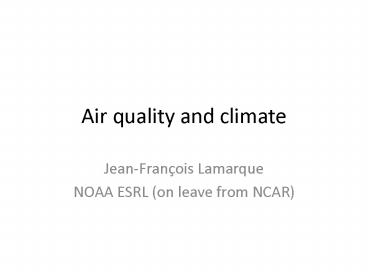Air quality and climate - PowerPoint PPT Presentation
1 / 18
Title:
Air quality and climate
Description:
Includes all major chemistry-climate modeling groups. Specific science questions in support of AR5: ... 2.4: 50 Tg methane (3 year run in this case, only ... – PowerPoint PPT presentation
Number of Views:53
Avg rating:3.0/5.0
Title: Air quality and climate
1
Air quality and climate
- Jean-François Lamarque
- NOAA ESRL (on leave from NCAR)
2
Amsterdam Sept. 2007 meeting
- Emissions 1850-2000
- 2000-2300 for each RCP
- Concentration of radiatively-active gases and
aerosols - Make those available on a decadal basis
3
Emissions
- Led international effort to provide improved
emissions 1850-2300, consistent across 2000 for
anthropogenic (including shipping and aircraft)
and biomass burning of reactive gases (not ODSs)
and aerosols
Historical (1850-2000) gridded anthropogenic and
biomass burning emissions of reactive gases and
aerosols methodology and application. Jean-Franço
is Lamarque, Claire Granier, Tami C. Bond, O.
Cooper,.Veronika Eyring, Angelika Heil, Mikiko
Kainuma, Z. Klimont, David Lee, Catherine
Liousse, J. R. McConnell , Aude Mieville, S.
Oltmans, Bethan Owen, D. Parrish. Keywan Riahi,
Martin Schultz, Drew Shindell, Steven Smith, Elke
Stehfest, Allison Thomson, John Van Aardenne,
Detlef Van Vuuren,
4
Horizontal resolution 0.5-degree
5
Status
- Emissions
- 1850-2000 available since July for all reactive
gases and aerosols (1850 and 2000 earlier) - 2000-2100 RCP4.5/RCP8.5 available for reactive
gases and aerosols - Concentrations (decadal averages)
atmosphere-only simulations - 1850-2000 ozone (V. Eyring)
- 1850-2000 aerosols (including dust and sea-salt)
to be made available soon. - 2000-2100 RCP4.5/RCP8.5 running (NCAR)
6
Surface ozone trends
GISS
CAM-chem
Obs
7
Ice-core record for chemistry H2O2
8
Aerosols
9
Decadal projection
- Change in air quality by 2030 from changes in
emissions and climate
Mexico City, 2006
Red Full mechanism Green Intermediate
mechanism Blue Fast mechanism Dots observations
Day of Year (2006)
10
(No Transcript)
11
ACC 4 (IGAC/SPARC activity)
- Drew Shindell/J.-F. Lamarque (leaders), Martin
Schultz (RETRO), Michael Schulz (AEROCOM),
Veronika Eyring (CCMval), Keywan Riiahi (IAMs) - Includes all major chemistry-climate modeling
groups - Specific science questions in support of AR5
- Diagnostic and analysis of radiative forcings
- Climate penalty of air quality
- Understanding long-term trends in tropospheric
chemistry - Climate impact of reducing ship emissions
12
ACC 4
- Phase 1 ACC-MIP (2009-2010)
- Timeslice experiments to complement AR5
- Emission sensitivity studies (isoprene, CH4, )
- Sensitivity to IAM modeling of emissions for each
RCP - Spread from using climatology (CCMs only)
- Meeting in Paris June 19-20 (in conjunction with
HTAP) to define/refine science questions to be
addressed in ACC-MIP and assign specific leaders
13
Hits/Misses
- Good overall historical emission anthropogenic
biomass burning dataset but inconsistencies
remain with CO2/land-use. No natural emissions. - Much better (than AR3/4) future anthropogenic
emissions of pollutants from harmonization (but
consistency at 2000, not 2005) - No air-quality specific scenario (sensitivity
could be studied from same RCP from different
IAMs) - Lack of funding (for travel) has made the
progress much slower than expected - Suggestion make effort on emission/concentration
a more integrated part of planning
14
Air quality specifics
- High-resolution enables representation of
pollution events (surface condition for ozone,
CO, aerosols) and regional impacts on climate
but limited by accuracy of emissions - Feedback on vegetation and CO2?
- No direct link to AQ impact community
15
(No Transcript)
16
ACC simulations
- Phase 1 ACC-MIP (focus on troposphere)
- Time-slice experiments to complement AR5 CCMs
and CTMs (need stratosphere) - Emission sensitivity studies
- Sensitivity to IAM modeling of specific RCP
- Spread from using climatology
Timeslice runs including detailed chemistry
diagnostics and separating aerosol indirect
effects. Each run 4 years with prescribed SSTs
taken from AR5 runs (SSTs should ideally be
decadal means around given years), 2-month
initialization suggested. 8 historical times
(1850I, 1890, 1910, 1930, 1950 I, 1970, 1990,
2000 I) 5 future times (2010 I, 2030, 2050 I,
2070, 2100 I), each with 2.6 W/m2 Representative
Concentration Pathway (RCP), 4.5 W/m2 RCP and 8.5
W/m2 RCP.
17
ACC simulations
- Phase 1 ACC-MIP
- Timeslice experiments to complement AR5 (38
simulations, 160 years) - Emission sensitivity studies
- Sensitivity to IAM modeling of specific RCP
- Spread from using climatology
Run at year 2050 (SSTs from 1), 1 year runs
(2-month initialization), models own
distribution of given emission scaled
uniformly 2.1 100 Tg isoprene 2.3 20 biomass
burning (all species) 2.4 50 Tg methane (3 year
run in this case, only applicable for models with
sources/sinks of methane rather than
prescribed) 2.5 2 Tg N/yr lightning NOx
18
ACC simulations
- Phase 1 ACC-MIP
- Timeslice experiments to complement AR5 (38
simulations, 160 years) - Emission sensitivity studies
- Sensitivity to IAM modeling of specific RCP
- Spread from using climatology
Same 4 year timeslice runs as in ACCMIP_1 for
2050 and 2100 but using emissions for the 2.6 and
4.5 RCPs from the other available IAMs. Runs
without AIE only (as these are not climate runs)































